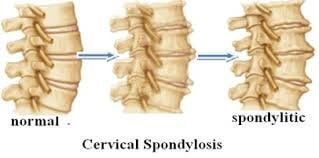Understanding Cervical Spondylosis
, 6 years ago
Understanding Cervical Spondylosis:
After
Back pain,
neck pain is the second most common musculoskeletal complaint reported by patients. Neck pain can be arising due to various causes. However, a neck pain that is attributed to postural or mechanical causes is referred to as
Cervical Spondylosis. It is also referred to as cervical osteoarthritis or neck arthritis.
Causative factors:
1. Ageing:
a. Bone spurts: Sometimes, the body grows extra bone to make the spine robust. If this bone presses onto a nerve or directly the spinal cord, it can result in pain.
b. Degenerated disc: Discs provide natural cushioning to the spinal joints. When they thin out as part of normal aging, there is increased friction between the vertebrae, narrowing of the space for the spinal nerves. All these can lead to pain.
c. Disc herniation: When there is break in the continuity of the outer annulus fibrosus of the intervertebral discs, a part of the inner nucleus pulposus can herniate out of this break and press on nerves and spinal cord. This can cause numbness and pain along the area innervated by that specific nerve.
2. Injury:
Any injury sustained to the neck like an accident or fall can hasten the aging process
3. Overuse:
This can be occupational or recreational. If a person is engaged in any activity that involves heavy lifting or repeated movements, it can cause early wear and tear of these joints.
Symptoms:
1. Neck pain with movement
2. Stiffness in the neck
3. Pain may be referred to occiput, upper limbs and between the shoulder blades
4. Associated numbness, tingling and weakness in upper limbs
5. Balance issues
6. Dizziness or vertigo
Signs:
1. Restricted cervical range of motion
2. Diffused tenderness
Complications:
Radiculopathy and/or myelopathy
Treatment:
1. Medical:
Depending upon the severity of pain and disability, the doctor can prescribe medications such as NSAIDS, muscle relaxants, Gabapentin and steroids. It is very important to stick to the dosage and watch for any side effects. Report these back to your doctor who can revise your medications or adjust their dosage.
2. Physical therapy:
A licensed physical therapist will conduct a thorough physical examination to determine the root cause of this mechanical pain. Accordingly, he/she will formulate an individualized exercise program comprising of stretching, strengthening, postural awareness medical movements. This may also be accompanied by an ergonomic assessment of your workstation, home and car. Once you are pain-free, it is important to adhere to the exercise regime and postural advice as the chances of recurrences is very high in these patients.
3. Alternative therapy:
These include yoga, acupressure, acupuncture, Ayurveda and herbal therapies.
4. Surgery:
If all the above options have failed and there is a severe compromise in the individual’s ability to move his/her limbs or in case of life-threatening cases, surgical option is considered. Your surgeon will discuss with you the possible approaches he/she may adopt depending upon your case.
Visit
www.qispine.com to know more.


